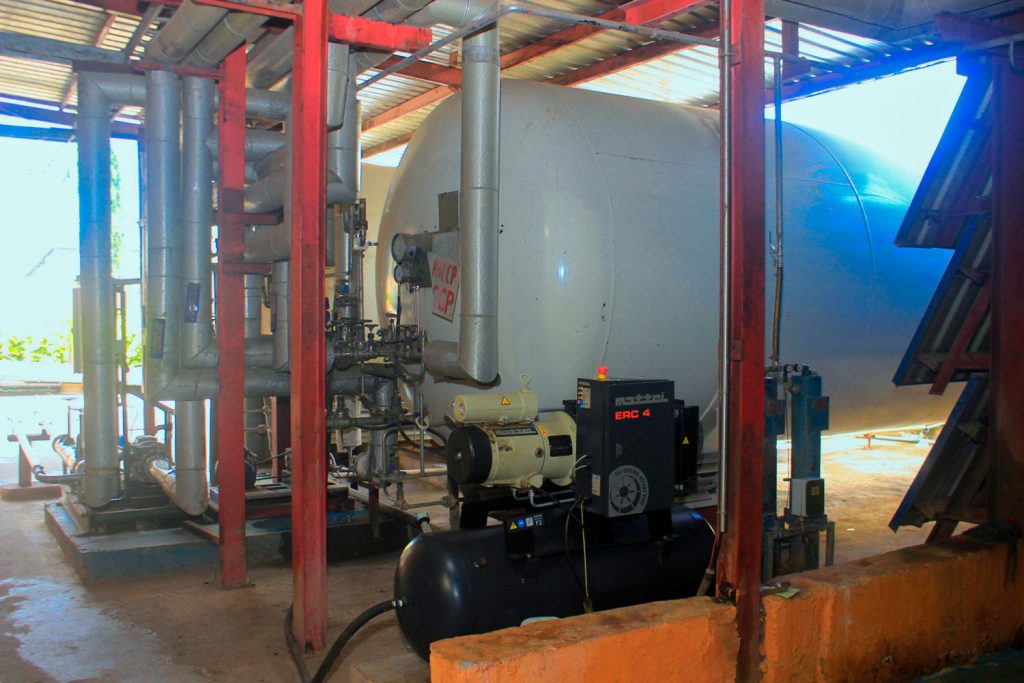Have you ever considered how the carbon dioxide in your favorite fizzy drinks is made? CO2 is an important gas used in many industries, not just for making fizzy drinks. In this complete guide, you will learn about the detailed process of producing and purifying CO2 at AIML.
Capturing Raw CO2 from Flue Gas
Extracting CO2 from Combustion Byproducts
The first step in AIM Processing’s CO2 production process involves capturing raw carbon dioxide from flue gas. This gas, a byproduct of combustion, is rich in CO2 and serves as the primary source material. At AIM’s facility, flue gas is obtained from the burning of natural gas or diesel fuel, which are common energy sources in industrial settings.
The Absorption Process
The flue gas is extracted through an absorption process using an amine-based absorbent. This selective capture of CO2 molecules while other components pass through is crucial for isolating CO2 from other combustion byproducts like nitrogen, water vapor, and trace contaminants.
Preparing for Purification
The absorbed CO2-rich solution is heated to release the captured carbon dioxide, which is collected and prepared for purification. This impure gas is concentrated and ready for rigorous cleaning processes to meet high standards for food-grade applications, ensuring its purity.
Purifying and Compressing the CO2
Removing Impurities
Once the raw CO2 is extracted from flue gas, it undergoes rigorous purification to meet food and beverage industry standards. It passes through scrubbers and filters to eliminate contaminants like sulfur compounds, hydrocarbons, and moisture. For applications requiring ultra-high purity, additional catalytic treatments are employed to achieve a 99.99% purity level.
Compression and Liquefaction
After purification, the CO2 undergoes compression, condensing the gas to a liquid state through multiple stages with intercooling to manage temperature. The liquid CO2 is then chilled and stored in insulated tanks, ready for distribution or conversion into dry ice for aviation industry needs.
Quality Control and Storage
Throughout the purification and compression process, AIM Processing uses advanced sensors to monitor purity levels during the purification and compression process, ensuring consistency and food-grade standards. The liquefied CO2 is stored in tanks to maintain optimal temperature and pressure, preserving its quality for industrial applications.
Storing High-Purity Liquefied CO2 for Use
Specialized Storage Tanks
Once the CO2 has been purified to 99.99% and liquefied, it’s crucial to store it properly. At AIM Processing, we use specialized storage tanks designed to maintain the CO2’s high purity and liquid state. These tanks are insulated and pressurized to keep the CO2 at the optimal temperature and pressure, preventing any contamination or phase changes.
Quality Control Measures
To maintain the food-grade quality of stored CO2, we implement rigorous quality control measures and regular testing through advanced monitoring systems. These systems track temperature, pressure, and purity levels, alerting our team to any deviations from set parameters, ensuring the stored CO2 remains pure and safe.
Distribution Preparation
When it’s time to distribute the CO2 to our clients in the brewing, bottling, distilling, and winery industries, we take extra precautions. The transfer process from storage tanks to transport vessels is carefully managed to maintain purity. We have separate facilities for aviation industry clients requiring dry ice to convert the liquid CO2 into solid form while maintaining its high-quality standards.
Conclusion
As you’ve seen, the CO2 production and purification process is a complex yet carefully controlled series of steps. By understanding this intricate process, you gain insight into the technology and expertise required to meet the growing demand for CO2 across various industries.
As AIML continues to refine and optimize its production methods, you can expect even greater efficiency and purity in the future. The next time you encounter CO2 in a product or application, you’ll have a newfound appreciation for its journey to reach that state.


